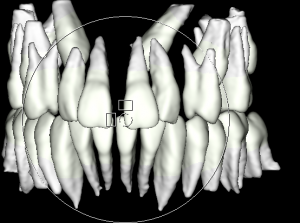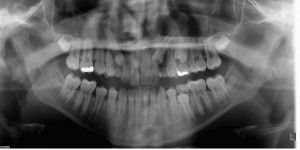Impacted Canines
 An impacted tooth simply means that it is “stuck” and cannot erupt into function. Patients frequently develop problems with impacted third molar (wisdom) teeth. These teeth get “stuck” in the back of the jaw and can develop painful infections among a host of other problems (see Impacted Wisdom Teeth under Procedures). Since there is rarely a functional need for wisdom teeth, they are usually extracted if they develop problems.
An impacted tooth simply means that it is “stuck” and cannot erupt into function. Patients frequently develop problems with impacted third molar (wisdom) teeth. These teeth get “stuck” in the back of the jaw and can develop painful infections among a host of other problems (see Impacted Wisdom Teeth under Procedures). Since there is rarely a functional need for wisdom teeth, they are usually extracted if they develop problems.
The maxillary cuspid (upper eyetooth) is the second most common tooth to become impacted. The cuspid tooth is a critical tooth in the dental arch and plays an important role in your “bite”. The cuspid teeth are very strong biting teeth and have the longest roots of any human teeth. They are designed to be the first teeth that touch when your jaws close together so they guide the rest of the teeth into the proper bite.
 Normally, the maxillary cuspid teeth are the last of the “front” teeth to erupt into place. They usually come into place around age 13 and cause any space left between the upper front teeth to close tighter together. If a cuspid tooth gets impacted, every effort is made to get it to erupt into its proper position in the dental arch. The techniques involved to aid eruption can be applied to any impacted tooth in the upper or lower jaw, but most commonly they are applied to the maxillary cuspid (upper eye) teeth. Sixty percent of these impacted eyeteeth are located on the palatal (roof of the mouth) side of the dental arch. The remaining impacted eye teeth are found in the middle of the supporting bone but stuck in an elevated position above the roots of the adjacent teeth or out to the facial side of the dental arch.
Normally, the maxillary cuspid teeth are the last of the “front” teeth to erupt into place. They usually come into place around age 13 and cause any space left between the upper front teeth to close tighter together. If a cuspid tooth gets impacted, every effort is made to get it to erupt into its proper position in the dental arch. The techniques involved to aid eruption can be applied to any impacted tooth in the upper or lower jaw, but most commonly they are applied to the maxillary cuspid (upper eye) teeth. Sixty percent of these impacted eyeteeth are located on the palatal (roof of the mouth) side of the dental arch. The remaining impacted eye teeth are found in the middle of the supporting bone but stuck in an elevated position above the roots of the adjacent teeth or out to the facial side of the dental arch.
Impacted Teeth (Expose and Bond)
An impacted tooth simply means that it is “stuck” and cannot erupt into function. Patients frequently develop problems with impacted third molar (wisdom) teeth. These teeth get “stuck” in the back of the jaw and can develop painful infections among a host of other problems. Since there is rarely a functional need for wisdom teeth, they are usually extracted if they develop problems. The maxillary canine is the second most common tooth to become impacted. The canine tooth is a critical tooth in the dental arch and plays an important role in your bite. The canine teeth are very strong biting teeth, which have the longest roots of any human teeth. They are designed to be the first teeth that touch when your jaws close together so they guide the rest of the teeth into the proper bite.
Normally, the maxillary canine teeth are the last of the front teeth to erupt into place. They usually come into place around age 12 and cause any space left between the upper front teeth to close tight together. If a canine tooth gets impacted, every effort is made to get it to erupt into its proper position in the dental arch. The techniques involved to aid eruption can be applied to any impacted tooth in the upper or lower jaw, but most commonly they are applied to the maxillary canine teeth.
Early recognition of impacted canine is the key to successful treatment. The older the patient, the more likely an impacted eye tooth will not erupt by nature’s forces alone, even if the space is available for the tooth to fit in the dental arch.
Treatment
Treating such a problem may involve an orthodontist placing braces to open spaces to allow for proper eruption of the adult teeth. Treatment may also require extraction of over retained baby teeth and/or selected adult teeth that are blocking the eruption of the all-important canine. Your Dentist or Orthodontist will provide Dr. Jong with a referral of which teeth/tooth needs to be removed, if any extra teeth (supernumerary teeth) or growths those are blocking eruption of any of the adult teeth. If the eruption path is cleared and the space is opened up by age 11 or 12, there is a good chance the impacted canine will erupt with nature’s help alone. If the canine is allowed to develop too much (age 13-14), the impacted canine will not erupt by itself even with the space cleared for its eruption. If the patient is too old (over 40), there is a much higher chance the tooth will be fused in position. In these cases the tooth will not budge despite all the efforts to erupt it into place. Sadly, the only option at this point is to extract the impacted tooth and consider an alternate treatment to replace it in the dental arch (crown on a dental implant or a fixed bridge). at the discretion of your Orthodontist and or General dentist who work very closely with Dr. Jong’s Oral & Maxillofacial surgery offices.
If the canine will not erupt when proper space is available, the orthodontist and Dr. Jong work together to get these interrupted canines to erupt. Each case must be evaluated on an individual basis but treatment will usually involve a combined effort. The most common scenario will call for the orthodontist to place braces on the teeth (at least the upper arch). A space will be opened to provide room for the impacted tooth to be moved into its proper position in the dental arch. If the baby canine has not fallen out already, it is usually left in place until the space for the adult canine is ready. Once the space is ready, the orthodontist will refer the patient to a Dr. Jong’s Oral & Maxillofacial office to have the impacted canine exposed and bracketed.
Surgery
In a surgical procedure performed in our office, the gum on top of the impacted tooth will be lifted up to expose the hidden tooth underneath. If there is a baby tooth present, it will be removed at the same time. Once the tooth is exposed, Dr. Jong will bond an orthodontic bracket to the exposed tooth. The bracket will have a miniature gold chain attached to it. Dr. Jong will guide the chain back to the orthodontic arch wire where it will be temporarily attached. This is done under general anesthesia.
Shortly after surgery (1-14 days) the patient will return to the orthodontist. A rubber band will be attached to the chain to put a light eruptive pulling force on the impacted tooth. Unless otherwise discussed by your Orthodontist. This will begin the process of moving the tooth into its proper place in the dental arch. This is a carefully controlled, treatment planning and progress of expose & bonds to be determined by your Orthodontist. Remember, the goal is to erupt the impacted tooth and not to extract it! Once the tooth is moved into the arch in its final position, the gum around it will be evaluated to make sure it is sufficiently strong and healthy to last for a lifetime of chewing and tooth brushing. In some circumstances, especially those where the tooth had to be moved a long distance, there may be some minor “gum surgery” required to add bulk to the gum tissue over the relocated tooth so it remains healthy during normal function. Dr. Jong or your orthodontist will explain this situation to you if it applies to your specific situation.
These basic principals can be adapted to apply to any impacted tooth in the mouth. It is not that uncommon for both of the maxillary canines to be impacted. In these cases, the space in the dental arch form will be prepared on both sides at once. When the orthodontist is ready, he/she will refer you to Dr. Jong, where he will expose and bracket both teeth in the same visit so the patient only has to heal from surgery once.
The surgery to expose and bracket an impacted tooth is a very straightforward surgical procedure that is performed in the office. For most patients, it is performed under IV moderate or general anesthesia. The procedure is generally scheduled for 75 minutes if one tooth is being exposed and bracketed and 100 minutes if both sides require treatment. If the procedure only requires exposing the tooth with no bracketing, the time required will be shortened by about one half. These issues will be discussed in detail at your preoperative consultation with Dr. Jong.




